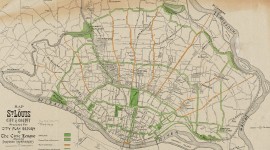Pioneer Information
Born in Béarn, France, to a prominent family, Laclède immigrated to New Orleans in 1755, becoming a trader and merchant. Laclède began a relationship with Marie Thérèse Chouteau, who, along with her young son, had been abandoned by her husband. Under Catholic law, Laclède was unable to marry Marie Therese, though the couple went on to have four more children together. In 1762, Laclède and fellow trader Antoine Maxent received rights to trade with the Native Peoples of the Mississippi and Missouri River Valleys, and a year later he departed with Marie Therese’s fourteen-year-old son Auguste Chouteau for the northern territory. With Chouteau, Laclède established a trading post and village at the confluence of the two rivers, which he named St. Louis. Laclède laid out the settlement, oversaw the deeding of property, and constructed the town’s first mill, effectively governing the territory until French deputies arrived in 1765. After dissolving his partnership with Maxent in 1769, Laclede and Chouteau entered a business partnership with Sylvester Labbadie. Declining in health, Laclede returned to New Orleans in 1777 to settle debts. He died in 1778 on his return route to St. Louis, buried in an unmarked grave along the Mississippi River. Remnants of the original city street grid laid out by Laclède and Chouteau are extant along the west bank of the Mississippi, now preserved as Laclede’s Landing Historic District, listed in the National Register of Historic Places in 1976.








